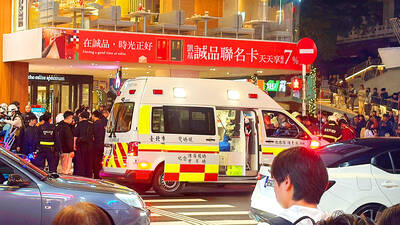When the sheet metal orders coming into his small business, High Metal, fell by half in October, it never occurred to Masaaki Taruki to lay off his workers.
Instead, he set about brainstorming new projects to occupy them. An indoor vegetable garden? A handicrafts workshop?
Because of government subsidies, Taruki in the last three months installed rows of parsley, watercress and other plants, using factory space that has been empty since the company disposed of unused machinery. High Metal’s staff tend the sprouts religiously, topping up the water supply, adding fertilizer and adjusting the fluorescent lights.

PHOTO: NY TIMES NEWS SERVICE
When sales at the machinery maker Shinano Kogyo in central Japan plunged some 70 percent late last year, the company started dispatching its idle workers to sweep the streets and pick up trash in the wider community, while remaining on the payroll.
Statistics released on Wednesday showed the Japanese economy suffered its worst contraction since 1955 in the first quarter, declining 15.2 percent on an annualized basis. But a far smaller portion of workers have lost their jobs in Japan than in either the US or the EU. (Japan’s unemployment rate last month was 4.8 percent, compared with 8.9 percent in the US and Europe.)
Analysts say this is because lifetime employment is alive and well in Japan, with the state playing a big role in keeping it so.
“Job tenure in Japan remains remarkably long,” said Peter Matanle, an expert on Japanese employment at the University of Sheffield in the UK. “Companies get rid of the buffers first. They’ll get rid of temporary workers, reduce overtime, reduce bonuses. They would squeeze their suppliers. They would do anything before considering cutting regular workers.”
But Japan’s obsession with keeping workers employed — even those who are not needed — comes at a cost.
Companies slash wages, which reduces consumer spending. Businesses become more reluctant to take on new recruits, shutting young people out of the labor force. Productivity plummets, hurting Japan’s competitiveness.
“By helping to maintain excess employment, you face the risk of keeping alive businesses that are no longer competitive and perhaps whose productive era is over,” said Hisashi Yamada, an economist at the Japan Research Institute, a private research group in Tokyo. “This could hurt employment in the long run. What you need is more structural change.”
The lifetime employment system, cemented in Japan’s postwar economic boom, bound dutiful workers and paternalistic employers together, producing a mutual loyalty (and labor harmony) rarely seen in the West.
By law, employers can cut workers’ hours but must pay at least 60 percent of their hourly wages during that time. The government has budgeted ¥60 billion (US$624 million) this year to reimburse companies for half of those payments. In March, about 48,000 companies sought subsidies for 2.38 million employees, government figures showed.
Even large exporters, like Nissan Motor and NEC Electronics, have used the subsidies to keep workers employed despite shorter factory hours.
In a recent survey by the Nikkei Shimbun, zero percent of large business owners said they had plans to lay off permanent staff members, compared with 39 percent in South Korea. Experts say that without subsidies, Japan’s unemployment rate would be as much as 2 percent higher.
Since Japanese workers are hard to lay off, companies have turned to temporary workers, who receive lower pay and fewer benefits, and can be cut more easily. Such workers now make up a third of Japan’s workforce.
But keeping all those permanent staff members occupied is its own challenge.
Taruki’s factory in Osaka has been abuzz with activity over the vegetable garden. Using another government subsidy, Taruki also spent ¥5 million to start a handicrafts workshop, installing a laser etching machine in a tiny room that formerly housed employee lockers.
The company wants to make key chains and other trinkets, and is exploring ways to make ornaments for Buddhist altars.
“Even if the economy starts recovering, I’m doubtful whether we’ll ever bounce back entirely,” said Taruki, whose grandfather started the factory in Osaka decades ago.
“So I need to start filling in what we’ve lost. It’s the responsibility of companies to protect jobs, to grow them,” he said.

TRAGEDY STRIKES TAIPEI: The suspect died after falling off a building after he threw smoke grenades into Taipei Main Station and went on a killing spree in Zhongshan A 27-year-old suspect allegedly threw smoke grenades in Taipei Main Station and then proceeded to Zhongshan MRT Station in a random killing spree that resulted in the death of the suspect and two other civilians, and seven injured, including one in critical condition, as of press time last night. The suspect, identified as a man surnamed Chang Wen (張文), allegedly began the attack at Taipei Main Station, the Taipei Fire Department said, adding that it received a report at 5:24pm that smoke grenades had been thrown in the station. One man in his 50s was rushed to hospital after a cardiac arrest

SAFETY FIRST: Double the number of police were deployed at the Taipei Marathon, while other cities released plans to bolster public event safety Authorities across Taiwan have stepped up security measures ahead of Christmas and New Year events, following a knife and smoke bomb attack in Taipei on Friday that left four people dead and 11 injured. In a bid to prevent potential copycat incidents, police deployments have been expanded for large gatherings, transport hubs, and other crowded public spaces, according to official statements from police and city authorities. Taipei Mayor Chiang Wan-an (蔣萬安) said the city has “comprehensively raised security readiness” in crowded areas, increased police deployments with armed officers, and intensified patrols during weekends and nighttime hours. For large-scale events, security checkpoints and explosives

PUBLIC SAFETY: The premier said that security would be tightened in transport hubs, while President Lai commended the public for their bravery The government is to deploy more police, including rapid response units, in crowded public areas to ensure a swift response to any threats, President William Lai (賴清德) said yesterday after a knife attack killed three people and injured 11 in Taipei the previous day. Lai made the remarks following a briefing by the National Police Agency on the progress of the investigation, saying that the attack underscored the importance of cooperation in public security between the central and local governments. The attack unfolded in the early evening on Friday around Taipei Main Station’s M7 exit and later near the Taipei MRT’s Zhongshan

A car bomb killed a senior Russian general in southern Moscow yesterday morning, the latest high-profile army figure to be blown up in a blast that came just hours after Russian and Ukrainian delegates held separate talks in Miami on a plan to end the war. Kyiv has not commented on the incident, but Russian investigators said they were probing whether the blast was “linked” to “Ukrainian special forces.” The attack was similar to other assassinations of generals and pro-war figures that have either been claimed, or are widely believed to have been orchestrated, by Ukraine. Russian Lieutenant General Fanil Sarvarov, 56, head